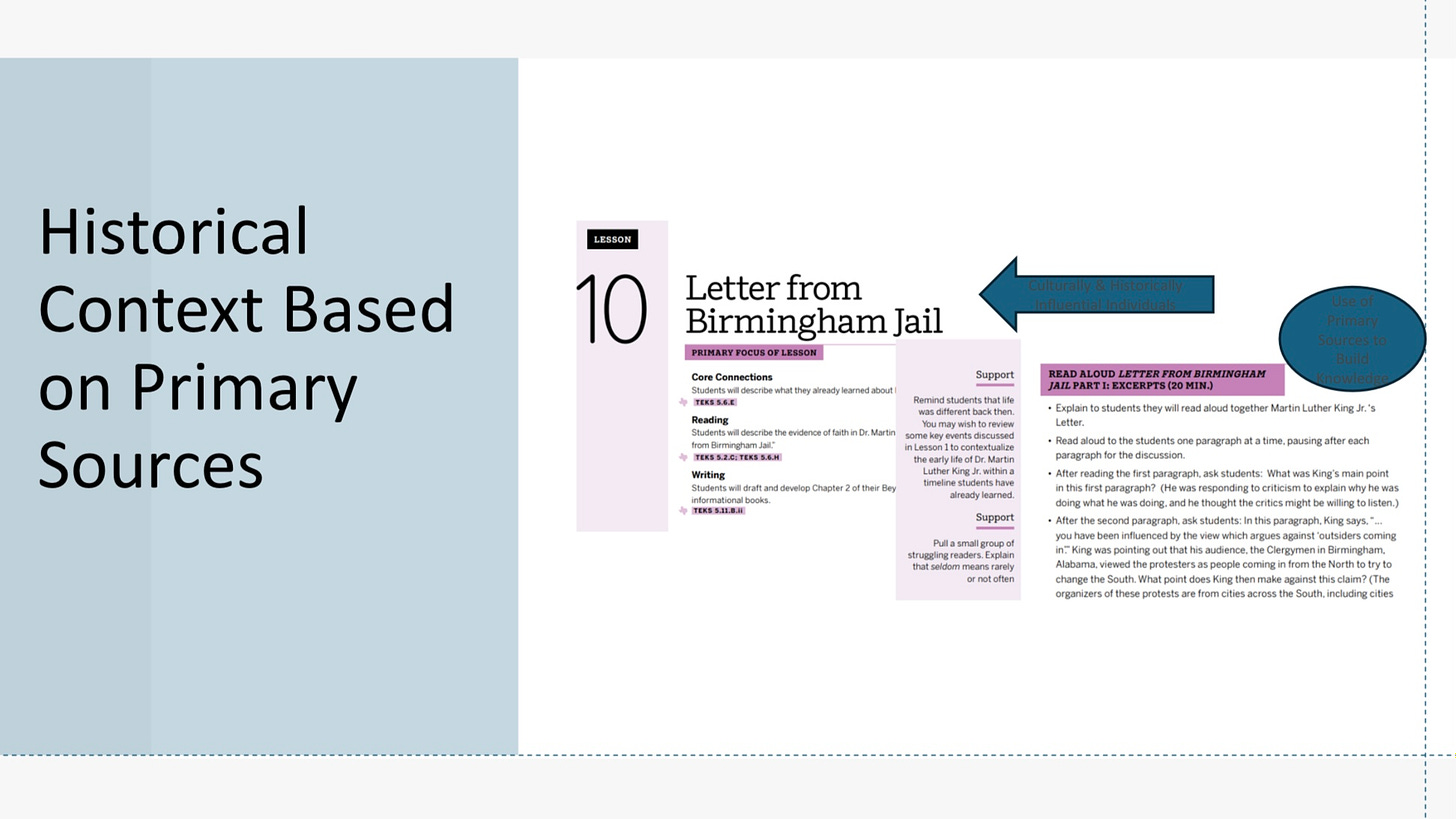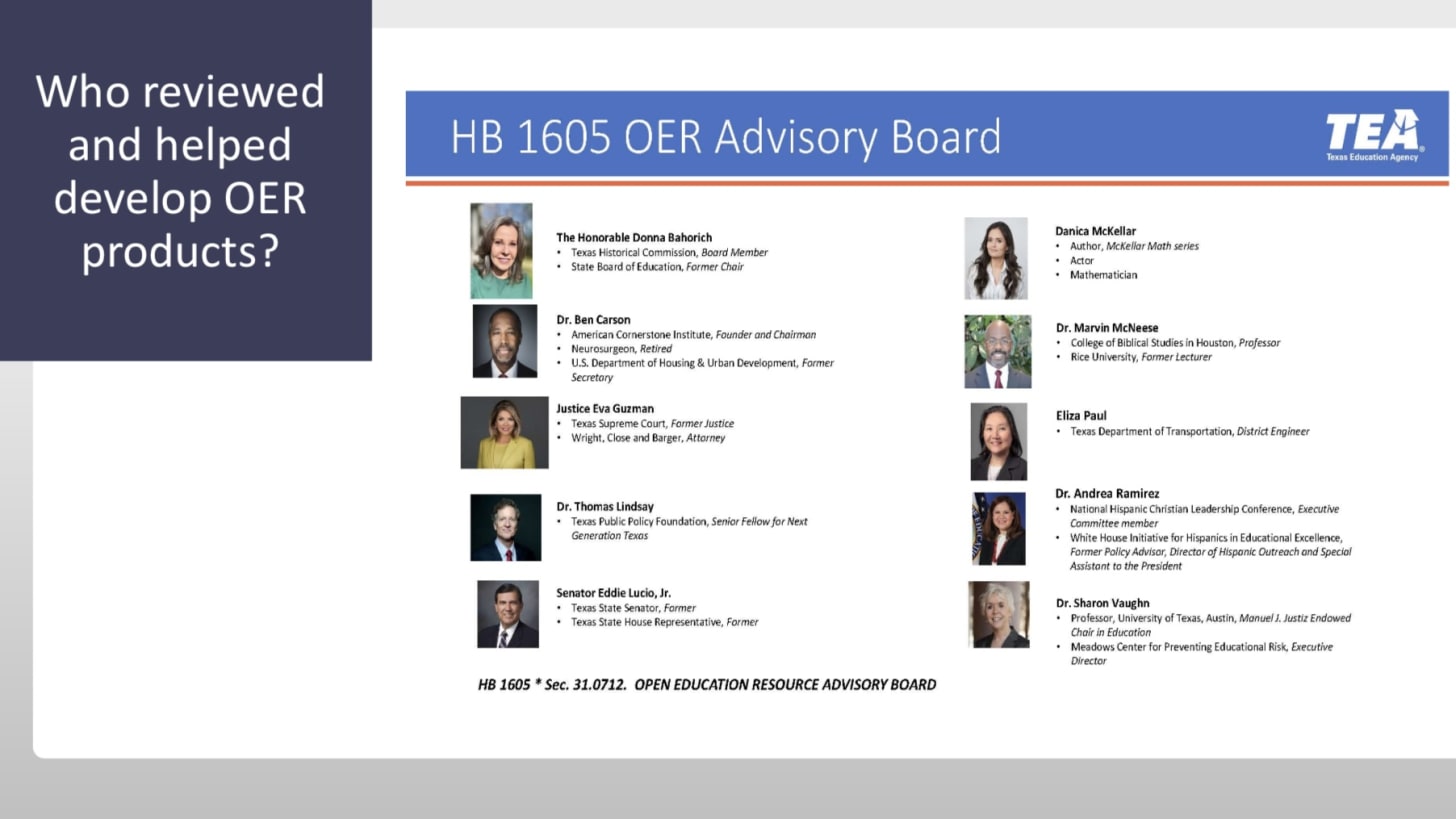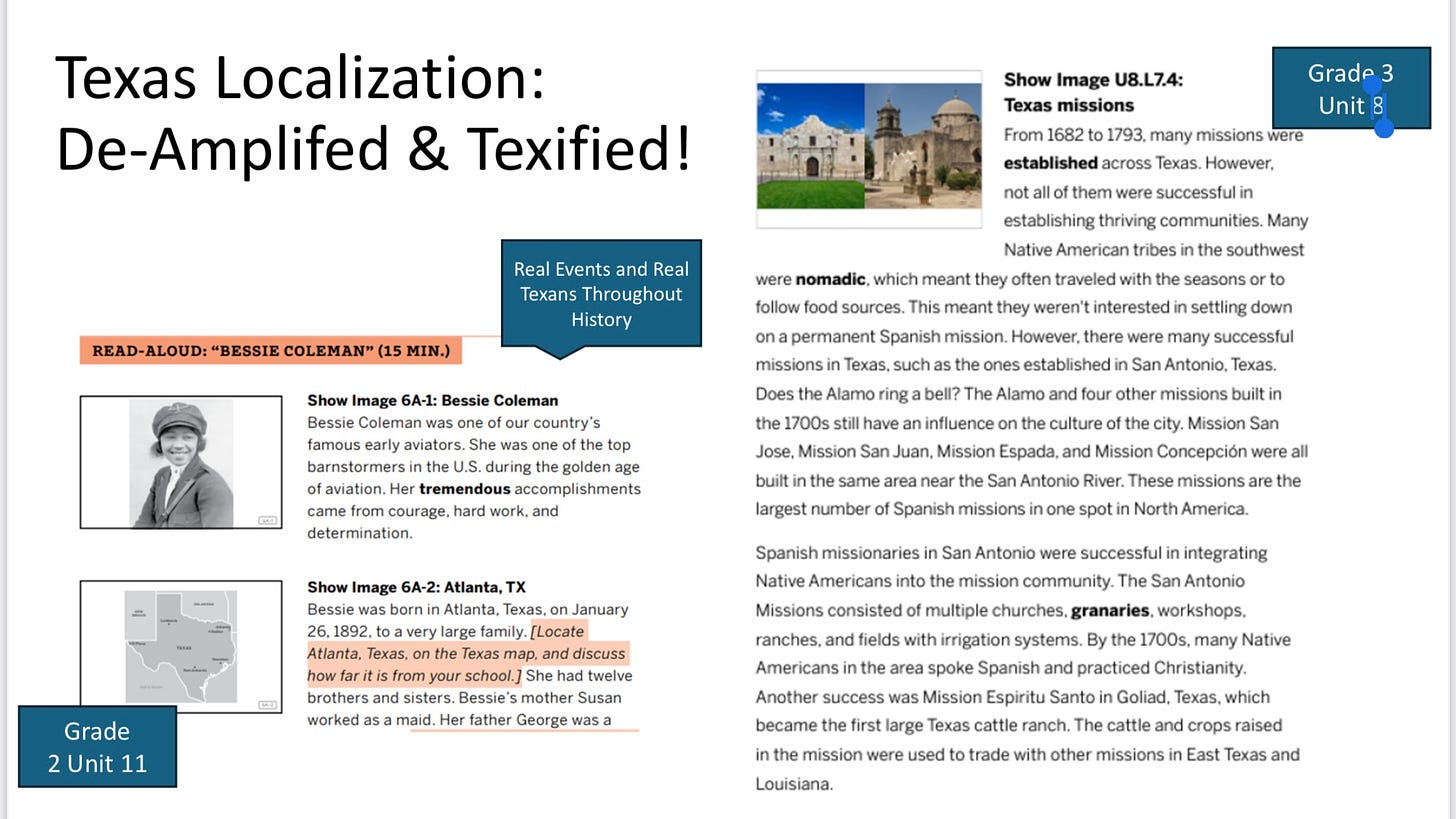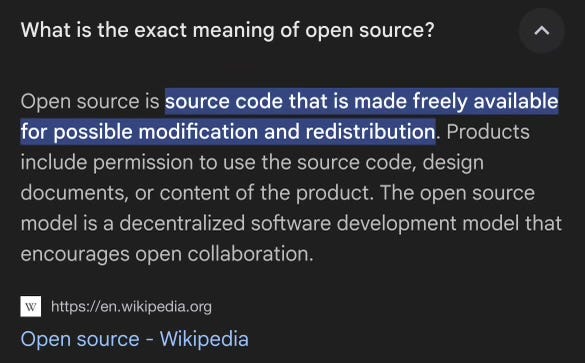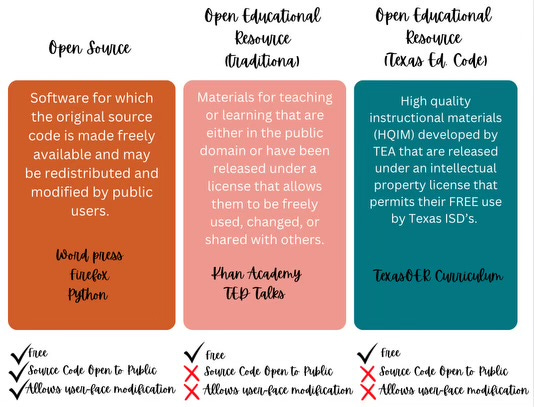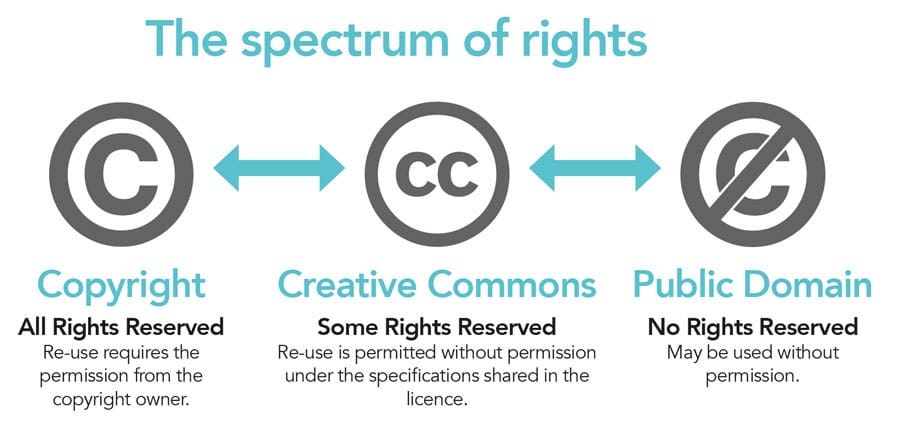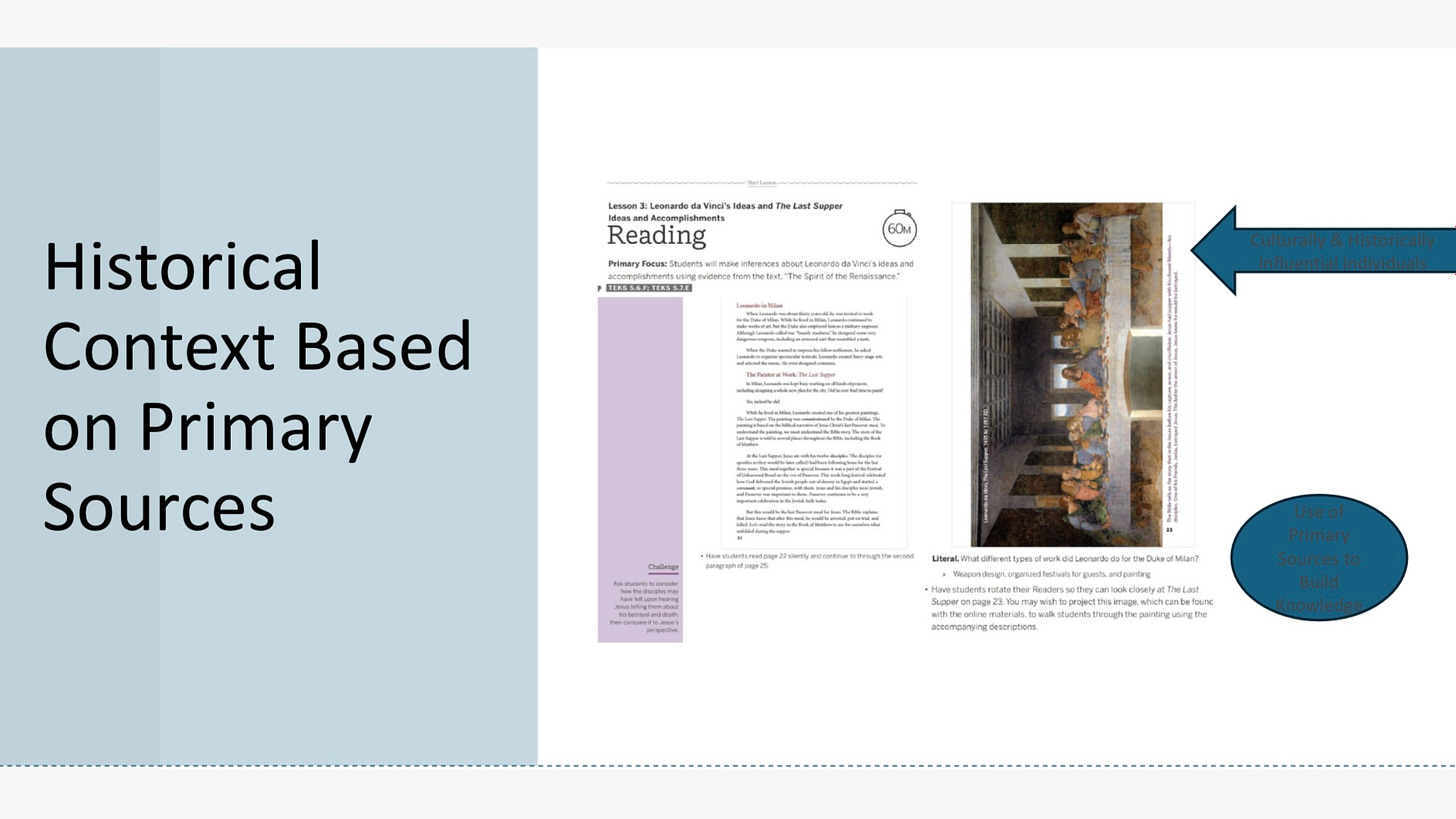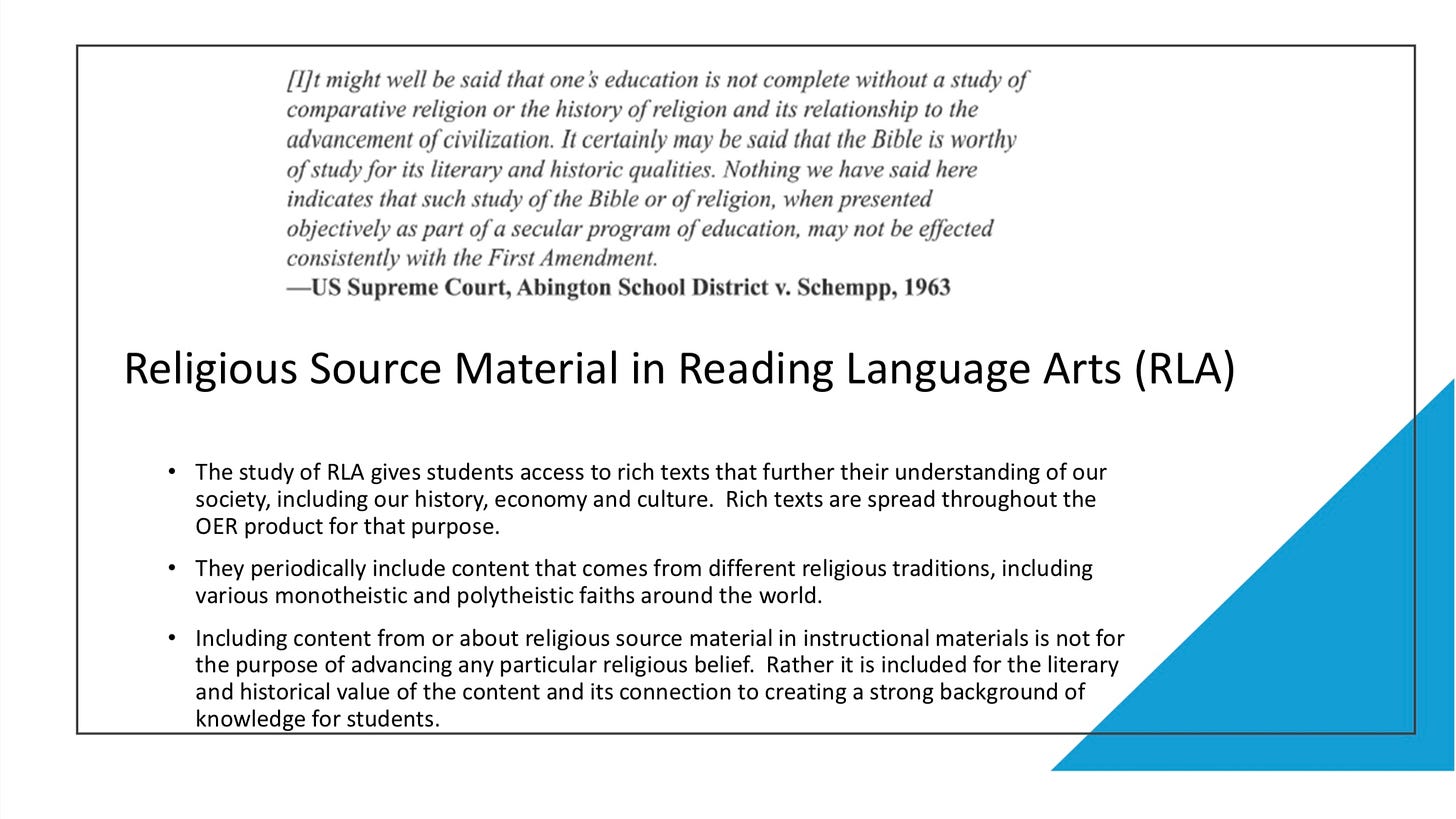

Discover more from Two Moms and Some Books
Action Alert: House Bill 1605 - A Classical Approach for Public Education
Please email testimony@sboe.texas.gov and ask them to, "Please adopt the curriculum created by HB 1605 without any amendments." Let's take a look at what is inside this gutsy legislation.
Before we begin, let’s first answer the question:
What is a Classical Education anyway?
The Trivium
Classical Education has a three-part approach— grammar, logic, and rhetoric— called the trivium.
The early years are called the “Grammar Stage” because, just as grammar is the foundation for language, this is where the foundation of a classical education is laid through memorization. Children in elementary years are very good at memorizing. “Rules of phonics and spelling, rules of grammar, poems, the vocabulary of foreign languages, the stories of history and literature, descriptions of plants and animals and the human body, the facts of mathematics — the list goes on. This information makes up the “grammar,” or the basic building blocks, for the second stage of education.” — Susan Wise Bauer (Well Trained Mind)
The second phase is the “Logic Stage,” introduced around fifth grade to students who are ready to think more analytically. “During these years, the student begins algebra and the study of logic and begins to apply logic to all academic subjects. The logic of writing, for example, includes paragraph construction and learning to support a thesis; the logic of reading involves the criticism and analysis of texts, not simple absorption of information; the logic of history demands that the student find out why the War of 1812 was fought, rather than simply reading its story; the logic of science requires that the child learn the scientific method.” — Susan Wise Bauer (Well Trained Mind)
The “Rhetoric Stage” introduced in the high school years, builds on the first two phases. This is when students begin to consider where they want to focus their studies for a career path. “The student of rhetoric applies the rules of logic learned in middle school to the foundational information learned in the early grades and expresses his conclusions in clear, forceful, elegant language.” — Susan Wise Bauer (Well Trained Mind)
The Quadrivium
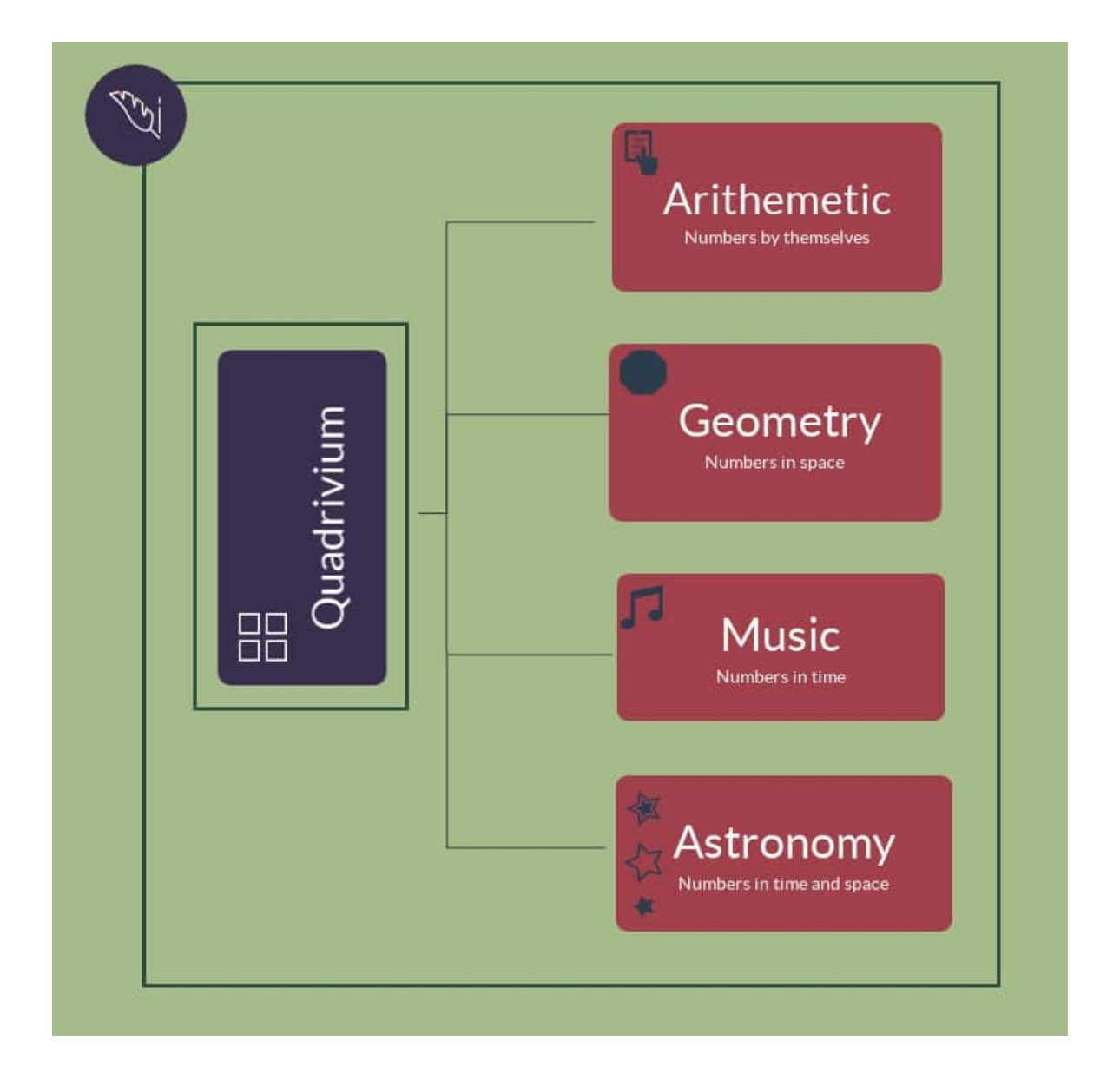
My research into Classical Education took me to the lesser known “quadrivium,” which is arithmetic, astronomy, music, and geometry.
“Practicing the liberal arts involves uncovering the beginning principles of each art, which span out into lines of reasoning, and then connecting them.” -Finn Cleary Hillsdale student in his article, Understanding the Trivium and Quadrivium
HB 1605 is a great first step in introducing a classical approach in the subjects included in the bill.
Making it Work for Texas Public Education
In Classical Education, history is taught in chronological order. Due to our TEKS (Texas Education Knowledge and Skills) some of the items will be taught out of order, but the curriculum does its best to adhere to that classical framework. Classical Education focuses on written (on the page) and spoken language, not with television or videos, but in relationship with each other - students and teacher. The State Board of Education is bringing these precepts to this new curriculum.
Currently, in the public education system, kids are told WHAT to think because the experts said so—no questioning. We want kids to be able to pursue truth for themselves. They should be reading original sources and learning to discern and make arguments as they get older. This is a valuable life skill for their future careers.
House Bill 1605, what is in this thing?
This article will not be exhaustive, and you can find more information by reading the bill, which you can find here:
House Bill 1605 and IMRA | Texas Education Agency
You can also find some of the written curriculum and review it yourself. It’s pretty great.
A few of my favorite things about this bill:
It focuses on PHONICS, eliminating the three-cueing method of teaching reading. This method has harmed many children who never catch up to their peers, especially those with dyslexia.
With three-cueing, basically kids are taught if they run into a new word, they should “guess” by looking at the context or pictures. Kids who learn this way often never learn how to decode long words. Prioritizing guessing over sounding out words can hinder a child’s comprehension and development.
An interesting podcast about the history of this method is called, “Sold a Story.”
It pushes students back to paper. Kids’ writing skills are abysmal these days, and most are graduating without any cursive skills whatsoever. This bill allows the state to produce a curriculum that brings writing with pencils back to the classroom, and cursive will be taught. The curriculum has been designed to be printed, NOT to be used on devices such as Chromebooks.
It’s open-and-go! Homeschool moms know what this means. This will free up a tremendous amount of time for teachers who labor over lesson plans. Currently districts purchase curriculums from large national companies such as Pearson or McGraw Hill. These curriculums were written for all 50 states, therefore Texas teachers have to spend time removing anything that does not meet the Texas TEKS and finding supplements for that part of the lesson plan.
The curriculum adheres to the Texas Informed Patriotism Act. This curriculum has been de-woked already. We don’t need to comb through content written by woke national corporations.
Read-alouds are incorporated throughout! Anyone who knows me, knows I believe read-aloud is one of the most important tools we have, and yet it is underutilized in the public schools. There is so much evidence that read-aloud is the best way to develop vocabulary because kids typically skip words they don’t know when they read to themselves.
Homeschoolers will have access to use it for FREE!! No logins, no registration, nobody knew you were there. This is great news for homeschoolers who struggle to pay for curriculum. The only cost will be for you to print the curriculum out because it is designed to be used as a hard copy, not on a device. If I were to do this, I would probably print and bind it myself to save some money.
It provides the tools for parents to be informed about everything. The entire curriculum is online so parents, with their login, can review everything, and see where their child’s class is. There are even dinner table conversation starters if you want to use them. If your child forgot her homework, you can print it out for her. Parents are completely integrated into this program as much as they want to be!
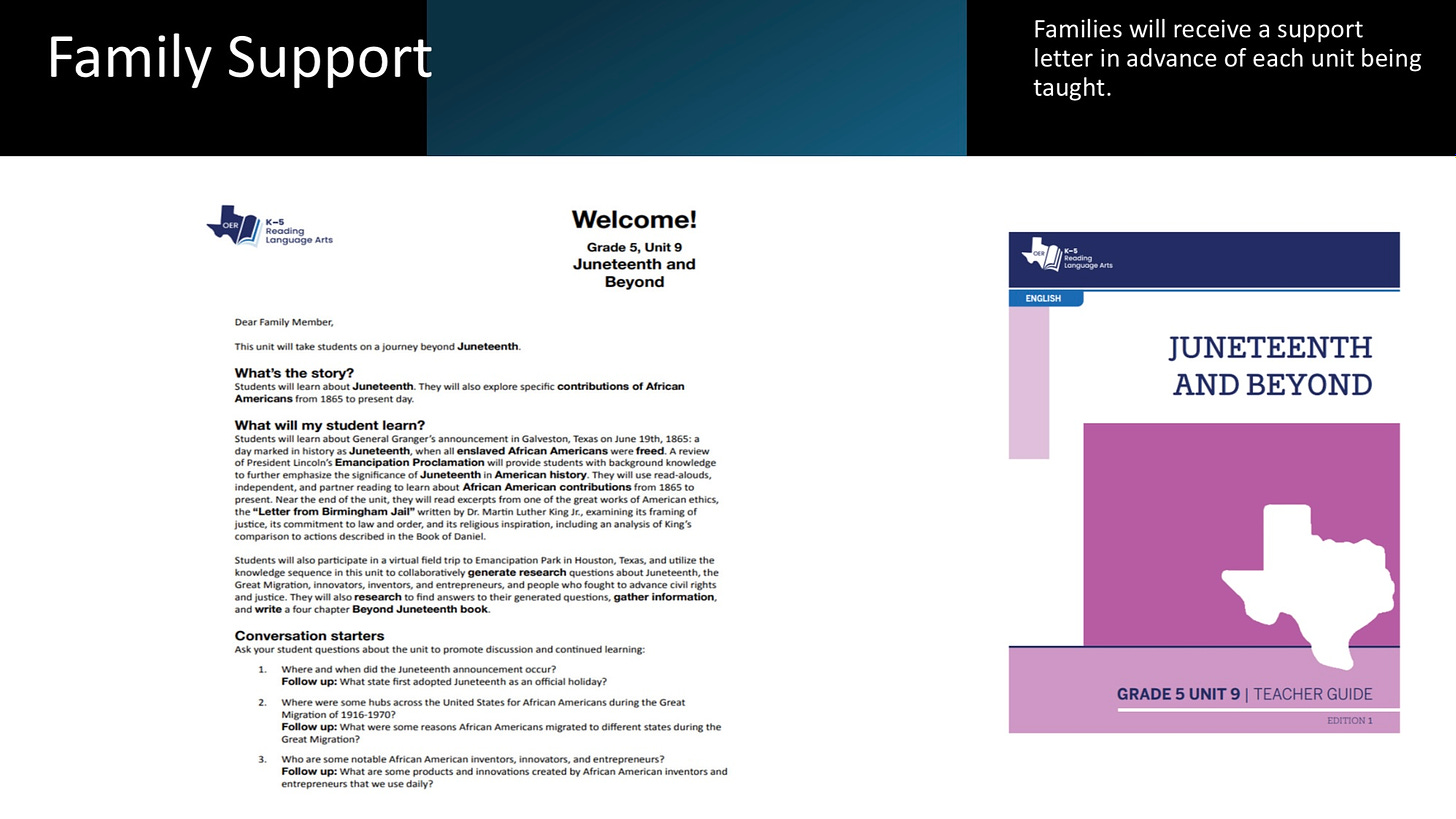
The curriculum takes the liberal agenda out of our classrooms, finally getting back to basics.
What about Juneteenth?
Juneteenth is a historical event that happened in Texas when word about emancipation proclamation reached Galveston. This is Texas history, and it’s frankly strange for this significant event to not be taught in Texas schools.
Environmentalism vs Conservation
Environmentalism puts the planet above people. Conservation is reasonable. It always amazes me when the same people who don’t want the county to be sprayed for mosquitos because of the toxins, don’t see the importance of passing on the tradition of conserving our planet to our kids.
Who has been involved in the development of this curriculum?
FACT vs MYTH
(🚩 = red flag argument) Red flag arguments tell me that a liberal is probably the originator.
MYTH: The curriculum is written by Amplify.
FACT: (Revised for clarity: 9/2/24) Texas purchased the infrastructure for the curriculum from Amplify, but Texas is not using any of their woke content.
From https://teaoer.com: “Several years ago, the TEA obtained all rights to the intellectual property of the Amplify Texas curriculum. This curriculum was used as a reference in creating the new TEA OER, however, TEA’s OER curriculum is materially different than any curriculum Amplify publishes.”
(Continued revision 9/2/24) Some educational content may be the same across various curriculums. Most short stories published in English Literature curriculum are Open Education Resources, and Martin Luther King Jr.’s letter from Birmingham Jail is OER. This content will be the same no matter which curriculum you find it in. Since Texas is using the infrastructure from Amplify, the brand Amplify is all over it. A great point I heard was, if I create a slide show on PowerPoint, this doesn’t mean that the content has anything to do with Microsoft politics.
Interestingly, Amplify walked away from the contract and would not give support, with no interest in helping Texas develop free thinking students. Get this: While Texas is developing this new classical education curriculum, other states are wanting to know if they can buy it, so Amplify develops a curriculum called “Texas Amplify” to sell to unsuspecting customers. This has confused concerned citizens in Texas even more.
MYTH: This is a true Open Education Resource.
FACT: The confusion is understandable to the untrained eye/ear, (I had to ask around to understand what was going on) but the Texas OER curriculum is most certainly NOT an open-source software program nor is it traditional open education content and cannot be edited via the public domain.
While the bill calls this new curriculum an Open Education Resource, it is not, and unfortunately, this has caused a lot of confusion. Defining terms is important. While there are many interpretations of OER, the one that matters relative to this bill is the definition of OER included in Texas Education Code.
Open Educational Resources (OER) are defined in the Texas Education Code, Section 51.451 as “teaching, learning, or research resources that are in the public domain or that have been released under an intellectual property license that permits their free use, adaptation, and redistribution by any person.
Unfortunately, this term has been conflated with “Open Source”, which is a software with an open-source code available to the public.
Here is a handy chart to help:
The curriculum will not be able to be changed like a Wikipedia page. This curriculum will be modified by the State Board of Education in open meetings.
MYTH: HB 1605 OER is a national security threat.
FACT: The infrastructure for the curriculum is not open-source code. It was purchased from Amplify and is fee-based similar to the accounting program your company might use to keep up with payroll. I believe some may be confusing Open-Source Code, which some companies like telegram use to build their infrastructure, with Open Education Resources which refers to content.
As explained above, Texas Education Code defines OER differently for their purposes. This is the content of the curriculum as provided, and it is not modifiable. It’s like a textbook. I can choose to skip a chapter or add a worksheet, but I can’t change the book.
MYTH: Kids will be on devices for four hours a day.
FACT: The language in the bill regarding four hours of access is indeed a bit confusing at first glance. However, after requesting clarification from TEA about intent here, it makes much more sense. This curriculum will bring kids back to writing on paper, read-alouds, and reading on the page, NOT devices. The four hours a day is an estimate for how long it will take for the child, in a classroom environment with those typical interruptions, to complete the work each day. This estimate is for when all subjects have been added for all grade levels. The districts are still free to supplement or substitute with any materials from approved curriculum vendors.
MYTH: 🚩 Teachers hate this curriculum because it’s going to be too difficult to teach. (Also, teachers have to be paid bonuses to teach it because it’s so horrible.)
FACT: Change is hard, and teachers’ unions are really good at throwing tantrums when they don’t want to follow evidence-based teaching. Teachers’ unions hate phonics instruction too. They fought tooth and nail against it while literacy rates continued to plummet, and costs of failed curriculum soared. This argument was a huge red flag. The curriculum will be easier once it’s learned and implemented.
(You know what’s really hard? Learning to teach kids with the three-cueing method. It’s overly complicated and convoluted. Phonics feels, “old fashioned.” Let’s stop overthinking things. Old fashioned works wonders.)
(update 9/24/2024) The following article has information about how the phonics program made a huge difference for children learning to read in districts that piloted the curriculum.
“But the best news of all, and proof of the OER concept, comes from initial surveys in the Lubbock and Temple Independent School districts. Lubbock saw a 21 percent increase in the number of African-Americans who now read at grade-level, along with a 19 percent increase for Hispanics—in the first year! Temple, a majority low-income and Hispanic district, saw a 13 percent increase in students now reading at grade level, also in the first year. Why isn’t this at least one of the headlines? Do the OER’s critics think it insignificant? And, if so, why?” -Thomas K. Lindsay, Ph.D.
Do Opponents of HB 1605 Really Want to Ban MLK from Texas’ K-12 Curriculum? - Texas Public Policy Foundation (thecannononline.com)
MYTH: The autonomy of local districts will be taken away.
FACT: ISD stands for Independent School District, and this bill gives the districts the right to use any, some or none of the new curriculum that will be available. School districts are also free to add additional material as they see fit.
MYTH: The Creative Commons Licensing indicates it’s liberal.
FACT: The Creative Commons copywrite is just a non-traditional copywrite used for intellectual property licenses that is commonly used for OER content. Again, this is like using a Microsoft product to create content. It doesn’t mean your content is liberal.
MYTH: Student books will cost a small fortune.
FACT: This was a very strange argument to me because it simply didn’t make sense. It is a spiral bound printout; why is this expensive? The answer is that it isn’t. The state will provide all printed, hard copy materials, and manipulatives at no cost to the school district.
MYTH: UNESCO is behind the curriculum.
FACT: Just because UNESCO was among the first to mention the term Open Educational Resources (OER) does NOT imply their involvement in the Texas curriculum. This is quite a jump. OERs have been in use for many years by various organizations and educators worldwide. Bottom line is there is no evidence linking UNESCO to this specific curriculum, just as there is no evidence supporting claims that Donald Trump colluded with Russia. Take another look at those who have been involved in writing the curriculum— solid conservatives like Dr. Ben Carson:
MYTH: Students will be taught bible study.
FACT: Bible references are not used for proselytizing but used as a source reference for certain historical events. For example, to have a robust dialogue about the founding of America, students must understand what motivated and inspired our founders. Why do our Founders believe that we are all equal with certain inalienable rights? What was the source of that belief? Why did prayer become a staple of the constitutional conventions?
"We shall be divided by our little partial local interests; our projects will be confounded; and we ourselves shall become a reproach and by-word down to future ages...I therefore beg leave to move — that henceforth prayers imploring the assistance of Heaven, and its blessings on our deliberations, be held in this Assembly every morning before we proceed to business, and that one or more of the clergy of this city be requested to officiate in that service."
--Benjamin Franklin, in James Madison's Notes on the Federal Convention
Update 9/28/2024: Find additional information on this topic from this expert who spent months reviewing the curriculum on the Advisory Board to TEA on the OER. Do Opponents of HB 1605 Really Want to Ban MLK from Texas’ K-12 Curriculum? - Texas Public Policy Foundation (thecannononline.com)
Texas Education Code Section 28.002 already requires public schools to include curriculum that is well-rounded and covers varying subjects, including from religious source material. TEC Sec. 28.002 requires that curriculum includes, “religious literature, including Hebrew Scriptures (Old Testament) and New Testament, and its impact on history and literature.”
MYTH: Teachers are granted immunity for teaching religion.
FACT: Teachers are granted immunity from prosecution from liberal district attorneys who want to use the curriculum for a political stunt. Teachers are granted immunity for following the curriculum with fidelity. Find this at the bottom of page 5/ top of page 6.
A Big Red Flag
🚩The Marxist teachers unions do NOT like this new curriculum at all, and they have mobilized to pressure the State Board of Education to try to kill the development of this classical education curriculum. We cannot let them win!
Please send an email:
📢Please email testimony@sboe.texas.gov and ask them to, "Please adopt the curriculum created by HB 1605 without any amendments." Please send this email TODAY.
That’s it; this one is easy. Feeling ambitious? Copy and paste the above bold message and send it to 10 friends asking them to do the same. (update 9-24-2024, keep the emails coming, we anticipate the SBOE making a decision sometime in November!)
Extra ambitious today? Send this article to 10 friends who might read it and share it on. Tomorrow, maybe find 10 more friends to share with. Please keep sharing!
Article written by Michele Nuckolls, homeschool mom who spends a lot of time in the public library with her kids.
Thank you to all who helped me with fact checking.
email: twomomsandsomebooks@gmail.com






